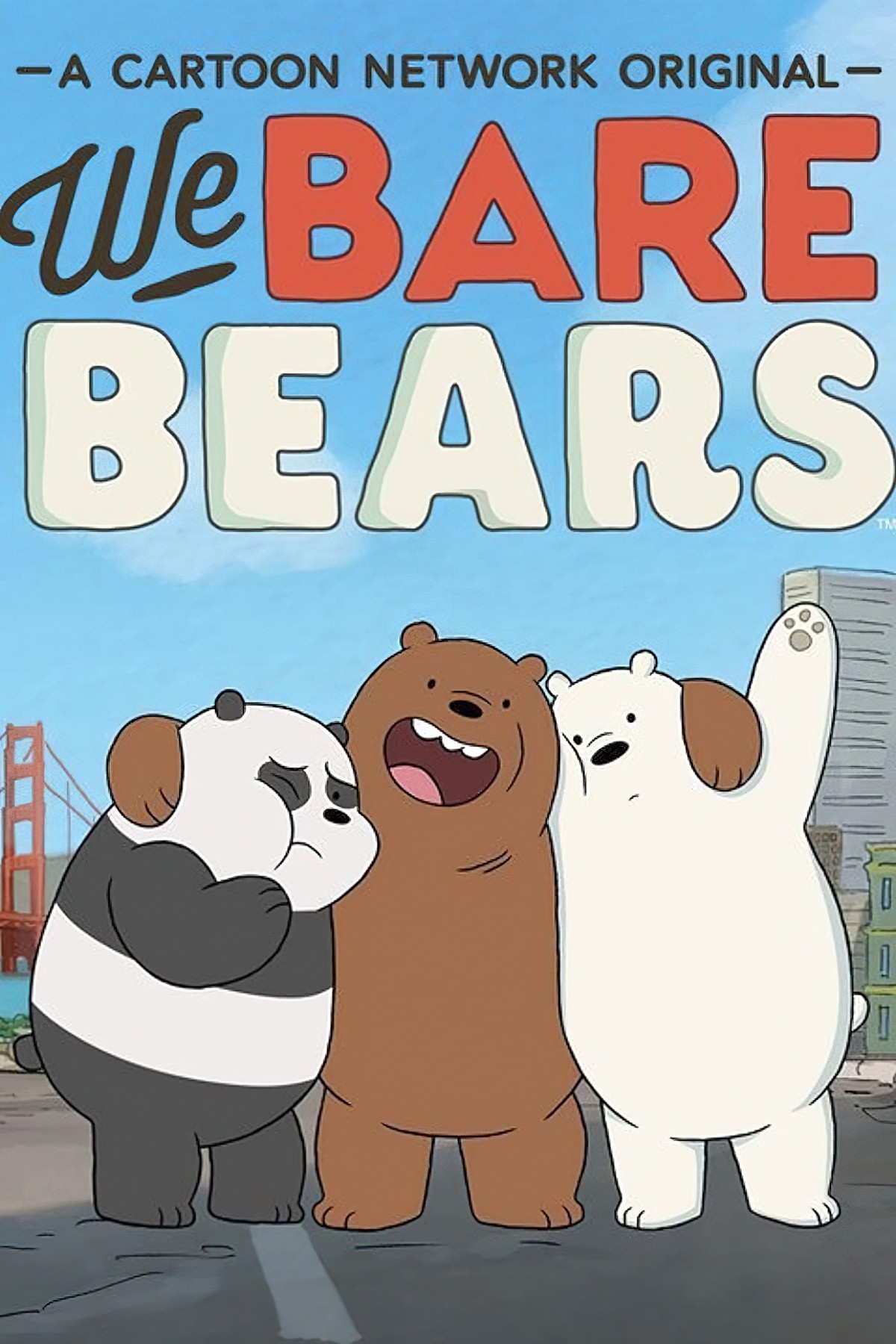We Bare Bears is a Cartoon Network show for kids which has a very high rating on IMDb. This is a sure sign it also appeals heavily to the users of IMDb, i.e. youngish men. In short, We Bare Bears has achieved a dual audience, and is therefore in the same league as Spongebob Squarepants, Silver Fang, Gravity Falls and Adventure Time.
If you have trouble following Gilmore girls due to its fast-paced dialogue, steer clear of We Bare Bears. Though designed for an even younger audience, the fast-paced nature of this Cartoon Network series is testament to how much modern young viewers can cope with. Or perhaps they don’t. Perhaps the fast-paced jokes are fast precisely because they are designed for the show’s large cohort of adult fans. We Bare Bears is an animated off-shoot of the similarly named The Three Bare Bears* by Daniel Chong. I think this was a better name. For some reason I find it hard to remember We Bare Bears — I keep thinking it’s Three Bare Bears, even before I knew it originally was.
*I find once you know both titles, it’s even more difficult to remember either title. I wonder who came up with the title, or if anyone else finds it hard to remember?
CHARACTERS IN WE BARE BEARS
CHARACTER ENSEMBLE: THREE OUTCAST DUDES
The three guys who are outcasts is not a brand new idea. Take another kids’ cartoon series Ed, Edd and Eddy which aired from the late 1990s and notice the similarities:
Ed, Edd n Eddy follows the lives of “the Eds,” three preteen boys who all share variations of the name Ed, but differ greatly in their personalities: Ed is the strong, dull-witted dogsbody of the group; Edd, better known as Double D, is an inventor, neat freak, and the most intelligent of the Eds; and Eddy is a devious, quick-tempered, bitter con artist, and self-appointed leader of the Eds. The three devise plans to scam the cul-de-sac kids out of their money, which they want to use to buy jawbreakers. However, problems always ensue, and the Eds’ schemes usually end in failure and humiliation.
The cul-de-sac kids do not include the Eds as part of their group, making the trio outcasts.
We Bare Bears is similar to Spongebob Squarepants in form and audience, though completely new in tone. Think Bob’s Burgers but for kids.
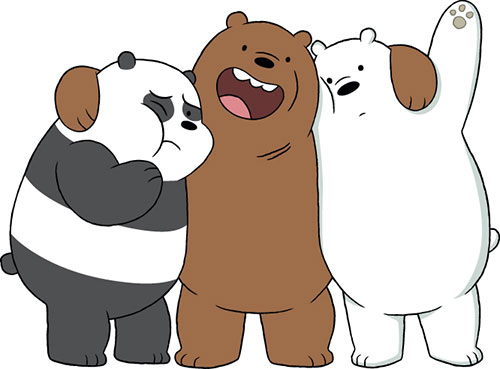
These are not child characters, after all. These are three young men living together as close friends — ‘brothers’ according to them — in what is basically a flatmate situation. These men are also child stand-ins:
- Grizz is the self-designated oldest brother who instigates a lot of the action by dint of his enthusiastic, often hare-brained plans. Grizz is the extrovert of the group.
- Panda, nick-named Pan-Pan, is unintentionally adorable (he wants to be a Manly Man), interested in dating women — the others are full of dating advice but apparently asexual — Panda has lots of allergies and is prone to anxiety.
- Ice Bear defies typecasting because although he’s the silent, manly type who is a whizz at martial arts and building gadgetry, he is also soft-hearted and kind, nurturing and maternal. Ice Bear also speaks of himself in third person, like one of the characters in a Seinfeld episode. I think this character is Autistic: One of his favourite things to do is sit alone in the freezer. He’s mostly non-verbal but also highly empathetic though sometimes fails to put his feelings into words, and has many hidden skills which he’s obviously picked up from his own studies. (My autistic daughter thinks this about Ice Bear too.)
A recurring character is the human Korean girl prodigy, Chloe. Another is some sort of hairy, big foot creature reminiscent of a Dr Seuss creation — Charlie. Charlie lives in the woods and is one of those friends who keeps dropping in uninvited, though why the bears (apart from optimistic Grizz) don’t want to hang out with Charlie isn’t entirely clear. I think he’s awesome. There’s also a regular looking woman who crops up everywhere, sort of like a recycled random person. You’ll see her going through the turnstile at the train station or something like that. Sometimes she says something.
THEMATIC CONCERN
Overall, We Bear Bears as a series is about our desire to fit in and be accepted. This has always been a human desire. As Hugh McKay says in his book What Makes Us Tick? we all wish to be taken seriously, most of all. This desire was probably never more true than now, in an age when two versions of each of us exists: The real world person, and the character we project onto our social media. Now we need both versions to be taken seriously, and we’re faced with the complication of recognising our true self amongst the pressure to look great and seem happy.
STORYWORLD OF WE BARE BEARS
A FAIRYTALE SETTING?
Like a good fairytale, this town (actually city — a shot of the bridge tells us it’s San Francisco even though San Francisco is never named) is set next to a vast expanse of woods. This is ostensibly the bears’ more natural habitat (well, Grizz’s natural habitat, at least, so of course he takes charge).
TECHNOLOGY
But these bears are tethered to technology. That’s what sets this series apart from earlier big hits from the late 90s and early 2000s (e.g. Courage The Cowardly Dog): this is for a generation of kids who are used to seeing people tethered to their smart screens. The Internet is front, right and centre.
A recurring opponent is a duplicitous Koala (not actually a bear, so doubly funny) who has a YouTube channel in which he pretends to be cute, but off-screen he’s a little bastard. He is also very rich. Technology also sends the bears Internet dating, dealing with accidentally posting something online and facing the backlash, anxiety that comes with getting too few likes on your post and other modern dilemmas unheard of just 20 years ago.
CAVE HOUSE
The bears are basically people, but their ‘bearness’ is used for comedy as the creatorssee fit. They live in a cave hybrid house, which in one episode is destroyed then recreated.
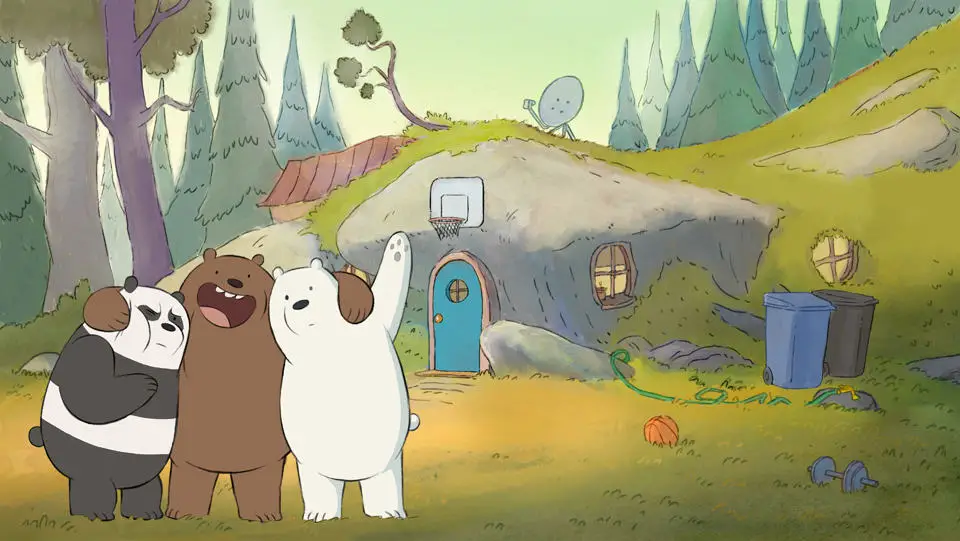
HIPSTERS
Within America, New York, Portland and San Fransisco are all thought to be hippie attractors.
There is a distinctly hipster vibe in We Bare Bears, and hipster mentality is both embraced and critiqued.
Chloe’s older classmates at what’s obviously meant to be Berkeley are inclusive types, if clueless about how to actually include a little genius kid. This inclusive vibe is evident throughout the series. In general I am annoyed when male characters are dressed up in overtly feminine attire, as it’s usually to make fun of those characters, but when these bears wear an apron or a girl’s pink, flowery cycle helmet, they somehow get away with it. That’s probably because no one within the world of the story is making fun of them. They face no negative consequences from being kind and feminine. This is highly unusual in a kids’ story, in which boys dressing as girls for punishment is a common gag. In most stories, boys in girl clothes are generally being punished, or at least getting into strife because of it. These hipster writers don’t use gender markers with transgression gags as their aim, though they’re not on entirely safe ground: if the audience finds a male character in female attire funny, where does the laughter come from?
Likewise, issues of race are never written to draw attention to themselves. Chloe happens to be Korean and the bears drink bubble tea, but the Korean aspects of this show do not exist to teach the audience to be inclusive. Story creator Daniel Chong is himself Korean American.
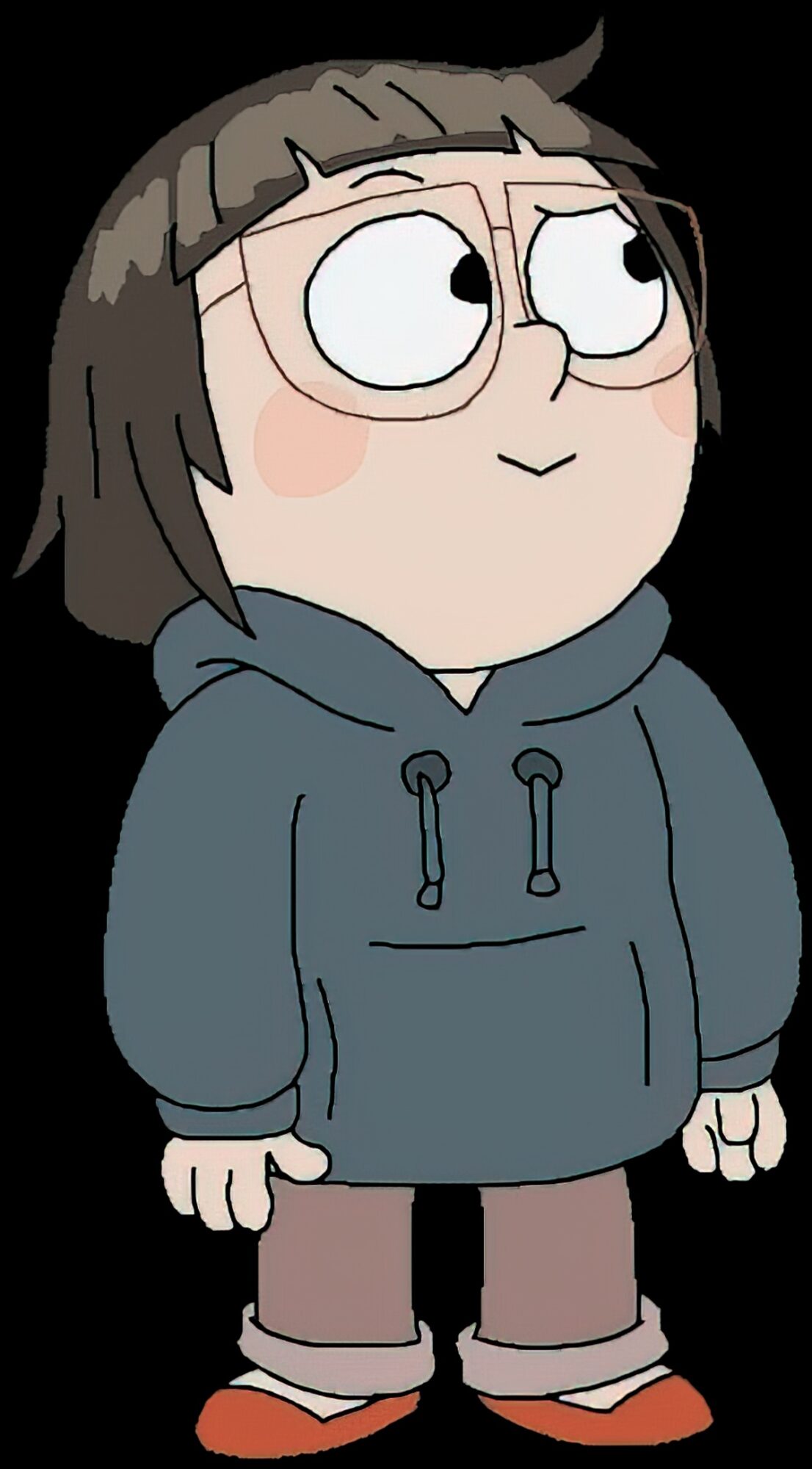
Hipsters may be inclusive in their attitudes, but the hipster wish to do Good has a flipside. In the TOTE LIFE episode the We Bare Bears are shamed for failing to take reusable fabric totes to a pretentious health food store. I find this highly relatable as this has also happened to me, at EcoMeats in Canberra. For the record, I didn’t take a plastic bag, but stumbled back out into the world clutching my meats precariously.
In this episode, the bears end up getting so into tote bags that they filltheir house with the things, which leads to the arrival of an environmental health officer. The messages in this episode are very specific in nature and also specific to this particular time in history when lots of us are worried about climate change, and are struggling to know what we as individuals can do to help the cause. The message here: Buying more stuff to seem environmentally friendly isn’t actually environmentally friendly. Also: Looking like you care for the environment is quite a different thing from actually being good for the environment. Without using the term ‘virtue signalling’, that’s what this episode is about. (Again, who knew the concept of virtue signalling 20 years ago, or even 10? ‘Virtue signalling’ was coined around 2009, but has really only been in common use since 2015, which is when this episode first aired.)
Hipsters, more than any other group, are thought to care about what others think of them. We see them lining up to buy ridiculously overpriced, over-hyped food at food trucks, wearing slouch hats and do yoga. A setting full of hipsters is the perfect setting for an exploration of themes of fitting in.
RECURRING GAGS
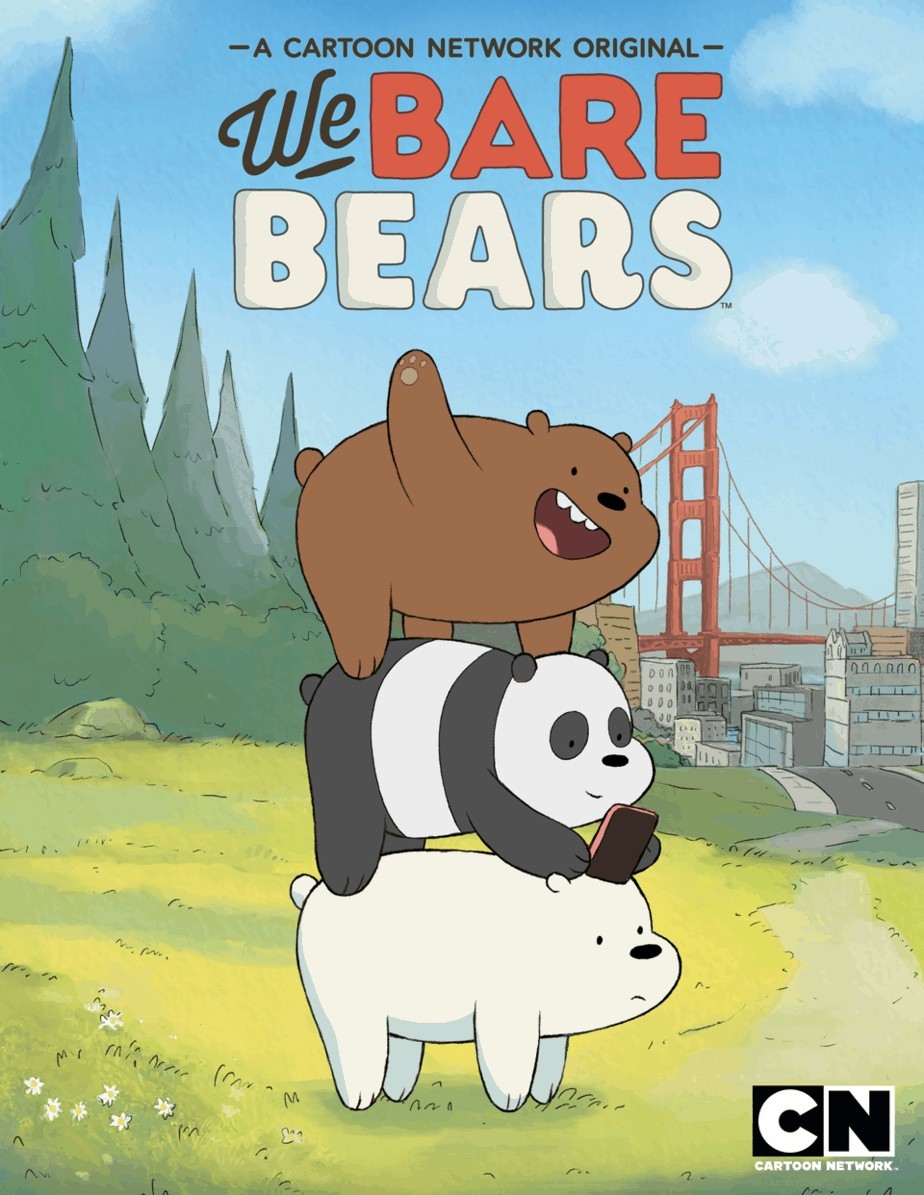
Comedy cartoon series need some sort of repeating visual gag. In We Bare Bears the stand-out example is that the bears get around by piling themselves on top of each other. The bottom bear walks while Grizz, at the top, gives orders and enjoys the view. This not only looks funny but says something about the social hierarchy. In one episode the bottom bears realise this isn’t fair, and their sense of injustice comprises the central psychological conflict. (Grizz ends up back on top after he ‘proves himself’ by defeating a pack of wolves.)
This visual gag is reminiscent of the stone age car in The Flintstones, in which Fred Flintstone ironically causes his family more effort by insisting on ‘driving’ a car, when they might as well just walk and do away with the car altogether.
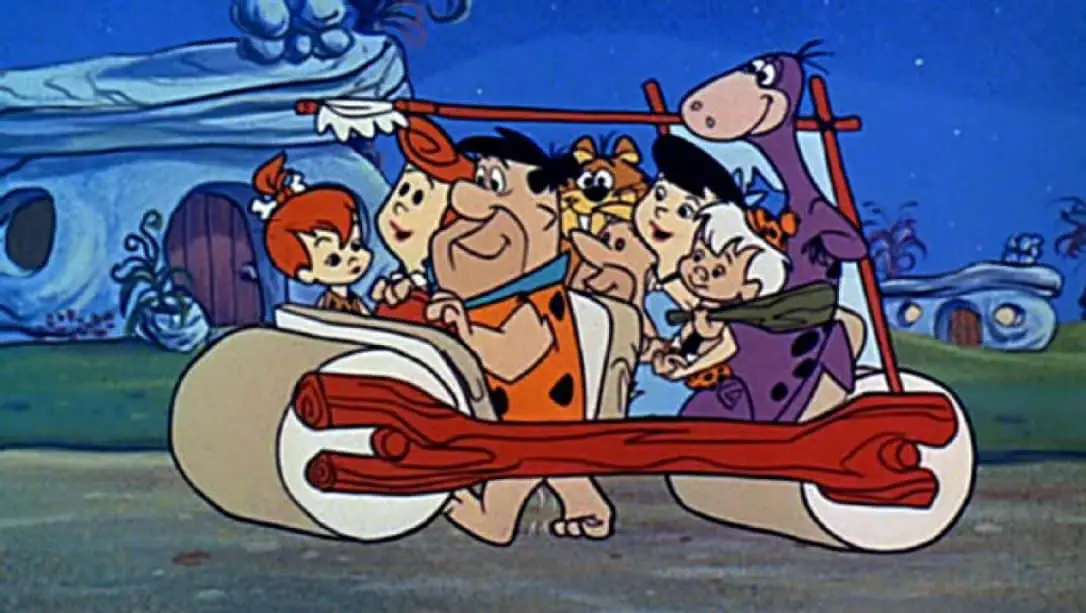
Courage The Cowardly Dog repeats in each episode the dog’s transmogrification as he struggles to communicate danger to his underwhelmed owners. CatDog features their very body as a joke, and a house set up to accommodate a creature which is half cat, half dog. Another cartoon series with a number of recurring visual gags is of course The Simpsons. Any fan doesn’t need to be told what those are.
STORY STRUCTURE OF WE BARE BEARS
We Bare Bears makes use of a variety of different comedy structures to mix up the laughs. Not only that, some episodes are clearly designed to be more funny than others. The episodes which flash back to when the bears were abandoned orphans are full of pathos, and my daughter feels quite sad watching them. The first of these, in which we meet the bears in a cardboard box on the side of the road, even turns into a musical.
PILOT
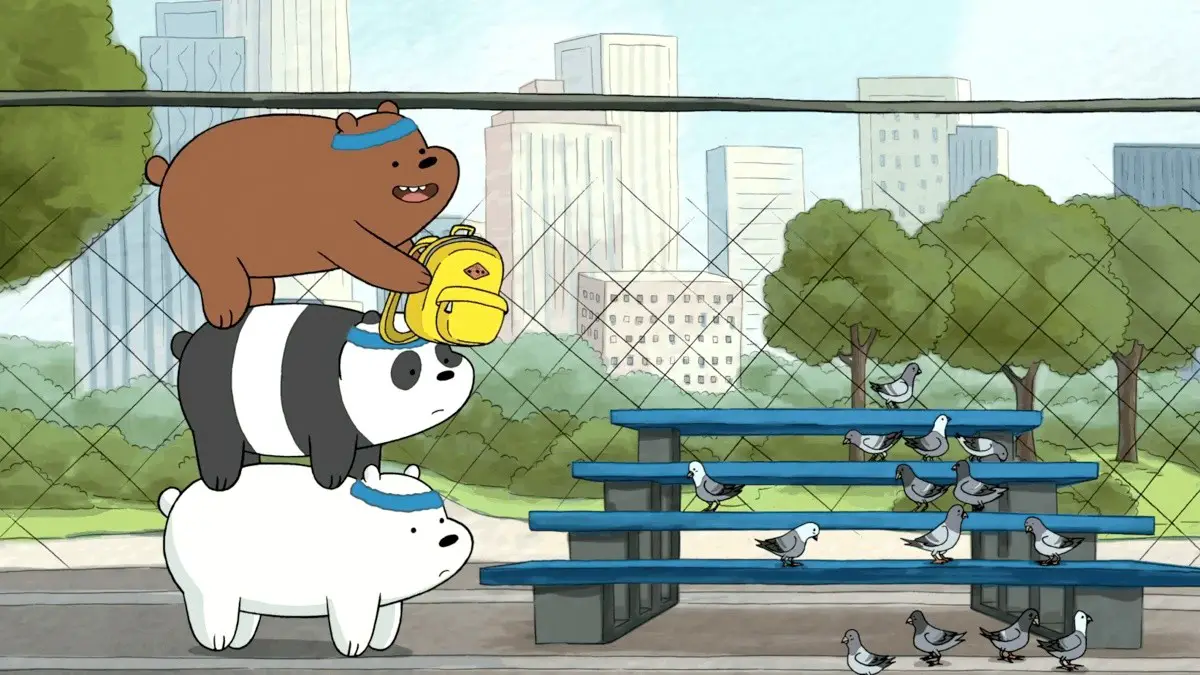
The pilot episode follows a commonly used story structure, borrowing tropes from the Mystery/Detective genre. Because this is the pilot episode, the writers are also charged with the task of setting up the rules of the world.
The first thing we’re shown about the bears is their obsession with their phones. A mid-shot on the bears’ hands show them putting their gadgets carefully into a shared backpack, talking about how important their phones are. Next they play basketball with a team of human teenagers, showing us that in this world we are to accept that it is ‘peopled’ with a mixture of human and animal characters and no one is to bat an eyelid. This is the bears’ ‘normal’ life (though later episodes show they’re not particular fans of basketball — this is just something they do when it suits).
The problem (inciting incident) is that after these bears played basketball they forgot their backpack with the phones. When they go back to the court, the bag — and the phones — are gone.
In typical children’s stories police are kind and omnipresent. Ironically in this show, the bears approach an uninterested police officer who turns out to be a parking warden. So asking the police for help doesn’t work out. In a nearby diner they come up with another plan. Panda draws highly rendered sketches of everyone he remembers on table mats. They are reprimanded for wasting table mats and for ordering nothing more than iced water.
They try to bribe the pigeons with stolen sachets of sugar because surely the pigeons saw which guy took their stuff. The audience learns that in this world, some animals are more anthropomorphised than others. (The bears are young men in animal bodies; the pigeons are naturalistic pigeons, but seem to be able to understand English, perhaps.) See also: Why so many talking animals in picture books?
The bears go on a journey to the library. “Why would the pigeon take us here?” “Because it lied to us!” The comedy comes from the fact that the pigeon is not anthropomorphised in the slightest and wasn’t ‘leading’ the bears anywhere.
At the library, the Internet is used to help solve the mystery — they can somehow track their phones’ whereabouts. Courage The Cowardly Dog was created when viewers were just started to make use of the Internet for research purposes. In Courage, the computer is personified, treated as a sage who dishes out ‘secrets’ and vital information which Courage couldn’t get any other way. Fast forward to 2015 and if a show is set in a world with the Internet, it makes zero sense if the characters don’t make use of it at every juncture, just like people do in real life. However, this still feels pretty new. Story creators are still choosing oftentimes to ignore the Internet, setting their stories in a world without it. If every modern storyteller had their characters tethered to their phones and computer stories would indeed get pretty boring, but because this doesn’t feel done before, the technology itself (here: GPS tracking, hidden recording capabilities, free library Internet) presents its own problems. Technology is almost a character, at times helpful, at other times leading them astray.
That night the bears go to ‘the place’. The audience needs no filling in: We are familiar with finding our phones using ‘Find My Phone’ apps and so on. The bears catch sight of a human guy wearing ‘their’ backpack. (Experienced story consumers know that this is probably not their backpack but an identical one.) To the tune of a Pink Panther-esque jazz soundtrack, the bears climb up the fire escape and are able to spy on this guy watching basketball on TV through his window. (In fiction, fire escapes are basically never used for escaping actual fires.) They will go into this guy’s house ‘ninja style’. (The audience may have noticed this at the very beginning of the episode when he put his nunchucks into the backpack, but Ice Bear is a ninja master.) Grizz is distracted by a packet of chips on the floor. Then they are distracted by the TV and reveal themselves. They manage to steal the backpack anyway, but don’t get far, stuck out on the ledge. This is the ‘near death’ sequence, which in a straight drama would be followed by a anagnorisis.
“Oh ho ho, that was close, fellas!” says Grizz, which is comical because they’re still at the height of danger, frozen in the spotlight, high off the ground.
They are magically surrounded by police choppers. It seems the writers are now making use of the children’s story trope in which the police are omnipresent and highly responsive. But ironically, it seems to be not in the bears’ favour.
Looking inside the backpack, they realise they’ve got the wrong bag. This contains a CD (anachronistically, unless of course, this guy is a hipster.)
The waitress down below complains that these bears only ordered ice-water and wasted all the table mats. They’re no good. The bears seem to have some sort of anagnorisis. “It looks like the real criminal might have been us and now we have to face the consequences,” says Grizz. Then, in a Thelma and Louise sort of ending, “Guys, if we go down, we do it all together.”
They are told not to jump all at once, but that’s exactly what they do (because they are a team). The safety trampoline coincidentally propels them into the lair of some sort of pigeon mafia. We accept this coincidence because this phase of the episode (the big struggle, anagnorisis, new situation) isn’t meant to take much time. In a way, these sequences have to happen — Grizz’s dialogue, in a self-aware way, takes the audience through the ‘motions of story’.
A policeman tells the bears they did them a huge favour stumbling onto the pigeon criminals. They’re one of the ‘most elusive of gangs’. The policeman hands the bears back their bag.
Grizz is again afforded comically on-the-nose dialogue: “Oh, so that pigeon at the park really was misleading us!” thereby answering a question the audience had. (To what extent are the pigeons anthropomorphised in this setting?)
The policeman offers yet another twist on the mystery: “Oh, this guy is actually working for us. He’s wearing a wire. Ain’t that the cutest thing? Nobody’s pressing charges, but don’t ever do that again!” The double ending is a spoof on noir thrillers, and is all the more funny because the twist comes so soon after the mystery is resolved. The writers seem to be saying, “We know this kind of story needs a twist, so here’s your ridiculous twist!”
The audience is given the briefest sense of the bears’ new situation when Grizz says, “You guys wanna watch a movie?” which is a great line because it shows the bears have learned nothing. They’re just as likely to blunder into adventure in time for the next episode, and will never get any older or wiser.
The “VIDEO DATE” episode is a good example of what’s known as ‘Imposter Comedy’, though the writers only make use of the first few steps then through in a reversal.
I have previously written about this kind of comedy (also known as ‘transgression comedy’) in regards to The I.T. Crowd. Basically, here’s the structure:
- Discontent
- Transgression with a mask (in which ‘mask’ is basically some sort of deception or disguise)
- Transgression without a mask
- Dealing with consequences
- Spiritual Crisis
- Growth without a mask
In episode 21, Panda sets up a webcam date with a French woman but is supremely nervous about it. After rehearsing the conversation with his bear brother flatmates, the conversation is not going well, so Grizz and Polar Bear step in to take his place after painting themselves up as pandas. In a Dirty Rotten Scoundrels sort of twist, when Panda’s mask comes off the romantic interest on the other side of the screen reveals that she is not actually French — she is from ‘Joisey’, and when the website accidentally had her down as from Paris she just ‘went with it’.
Discontent: Panda hasn’t got a girlfriend. (Of all the bears Panda is the only one who seems interested in dating, even though the other two are always full of dating advice.)
Transgression with a mask: The other bears step in, pretending to be Panda.
Reversal: They, too, have been duped.
Notice that in this episode of We Bare Bears there is no real spiritual crisis or growth. The just desserts are that the bears not the only ones who can lie online. The viewer is reminded that ‘you never know who you’re talking to on the Internet.’
As a side note, I do find stories in which a group of young men gang up to dupe a single young woman for sexual gain inherently creepy. I’m sure I’m not the only woman who feels like this, and it is almost mandatory to create a female character as wily and duplicitous as the male characters if you’re going to write a story like this. (Please don’t.)
